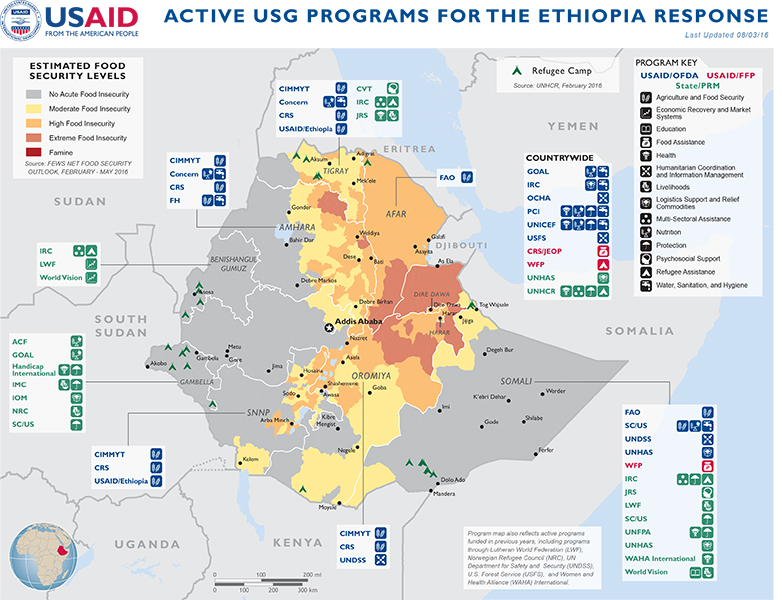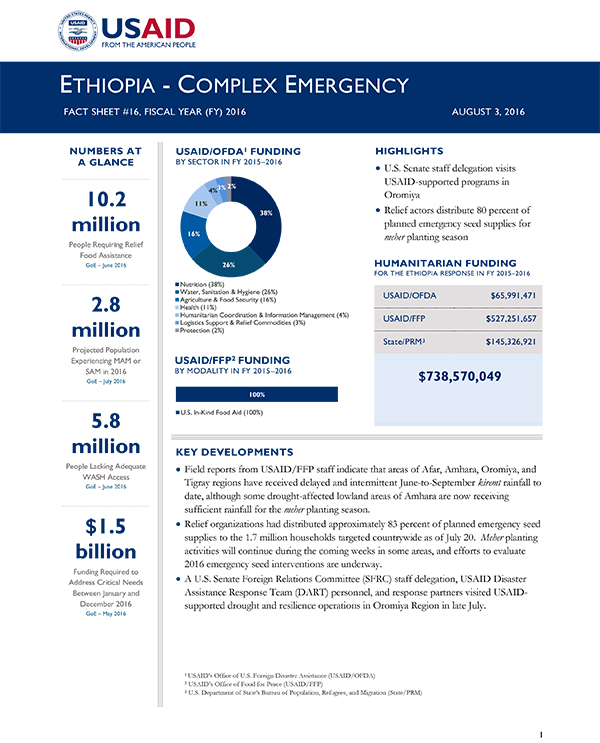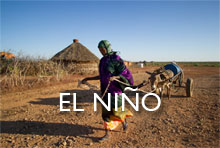- What We Do
- Agriculture and Food Security
- Democracy, Human Rights and Governance
- Economic Growth and Trade
- Education
- Ending Extreme Poverty
- Environment and Global Climate Change
- Gender Equality and Women's Empowerment
- Global Health
- Water and Sanitation
- Working in Crises and Conflict
- Disaster Assistance
- Political Transition Initiatives
- Conflict Mitigation and Prevention
- Countering Violent Extremism
- Disaster Risk Reduction
- Peacebuilding and Reconciliation
- Providing Safe & Secure Environments for Development
- Recovering From Crisis
- Resilience
- Tech Challenge for Atrocity Prevention
- World Humanitarian Day
- U.S. Global Development Lab
August 03, 2016
Highlights
U.S. Senate staff delegation visits USAID-supported programs in Oromiya
Relief actors distribute 80 percent of planned emergency seed supplies for meher planting season
Key Developments
Ethiopia Map - 08-03-2016 ![]() (pdf - 783k)
(pdf - 783k)
Numbers At A Glance
10.2 million
2.8 million
5.8 million
$1.5 billion
Humanitarian Funding
For the Ethiopia Response
FY 2015 - 2016
| USAID/OFDA | $65,991,471 |
| USAID/FFP | $527,251,657 |
| State/PRM | $145,326,921 |
| TOTAL | $738,570,049 |
Field reports from USAID/FFP staff indicate that areas of Afar, Amhara, Oromiya, and Tigray regions have received delayed and intermittent June-to-September kiremt rainfall to date, although some drought-affected lowland areas of Amhara are now receiving sufficient rainfall for the meher planting season.
Relief organizations had distributed approximately 83 percent of planned emergency seed supplies to the 1.7 million households targeted countrywide as of July 20. Meher planting activities will continue during the coming weeks in some areas, and efforts to evaluate 2016 emergency seed interventions are underway.
A U.S. Senate Foreign Relations Committee (SFRC) staff delegation, USAID Disaster Assistance Response Team (DART) personnel, and response partners visited USAID-supported drought and resilience operations in Oromiya Region in late July.
CURRENT EVENTS
Afar, northeastern Amhara, Oromiya’s East Hararghe and West Hararghe zones, and southeastern Tigray have received delayed and intermittent kiremt rainfall to date, according to field reports from USAID/FFP staff. These areas are chronically food-insecure and were severely affected by the 2015/2016 El Niño climatic event, which resulted in a poor 2015 meher season. The onset of 2016 kiremt rainfall was delayed by two-to-three weeks in most areas of Afar, with some zones having received moderate amounts of rain.
Rainfall has improved across southeastern Tigray and northeastern Amhara in recent weeks, with drought-affected lowland areas of Tigray’s Raya Alamata and Raya Azebo woredas, or districts, and Amhara’s Raya Kobo and Habru districts now receiving average levels of rainfall and sufficient moisture levels for planting staple crops. However, field reports indicate that kiremt rainfall remains well below average in lowland areas of East Hararghe, adversely affecting supplies of safe drinking water and the planting of haricot beans and other meher crops. The Government of Ethiopia (GoE) and relief organizations plan to closely monitor the performance and impact of kiremt rains in the coming weeks.
The GoE-led Flood Task Force recently revised the country’s flood contingency plan, originally released during the February-to-June belg rainy season, to raise awareness regarding flood concerns and preparedness strategies for the kiremt rainy season. The GoE National Meteorology Agency (NMA) projects that parts of Ethiopia will receive average or above-average rainfall during the current season. Additionally, the contingency plan accounts for NMA forecasts of a 2016/2017 La Niña climatic event developing in the coming months, potentially resulting in heavy rains, flooding, and landslides—among other climatic effects—in kiremt-receiving areas. The revised contingency plan projects that flooding and other harsh weather conditions could affect up to 1.1 million people, including potentially displacing approximately 460,000 people, during 2016. As of July, heavy rainfall and flooding had displaced an estimated 320,000 people in 2016, according to the Flood Task Force.
Several USAID offices convened on July 25 in Ethiopia’s capital city of Addis Ababa to discuss La Niña planning and preparedness. USAID staff reviewed lessons learned from the 2010/2011 La Niña, including USAID response measures, as well as potential response mechanisms related to existing resilience programs to address expected 2016/2017 La Niña impacts. In anticipation of La Niña, USAID partner the International Rescue Committee (IRC) has pre-positioned approximately 2,000 emergency relief item kits for rapid dispatch to flood-prone areas of Ethiopia and is assessing additional La Niña flood response efforts.
FOOD SECURITY AND NUTRITION
As of July 27, the fourth and fifth rounds of 2016 relief food assistance—targeting approximately 10.2 million drought-affected people, identified by the 2016 Humanitarian Requirements Document (HRD)—were 89 percent and 26 percent distributed, respectively, according to the UN World Food Program (WFP). The GoE and relief actors began the sixth round of relief food assistance on July 29, according to the Logistics Cluster—the coordinating body for humanitarian logistics activities, comprising UN agencies, non-governmental organizations (NGOs), and other stakeholders. Similar to previous rounds, the fifth round of relief food assistance has experienced delays due to challenges offloading humanitarian cargo at the Port of Djibouti, complications with cross-border transportation companies, and difficulties navigating terrain during kiremt rains, among other factors.
The May and June allocations of the GoE-led, USAID-supported Productive Safety Net Program (PSNP) are 76 and 12 percent dispatched, respectively, with each allocation containing more than 29,400 metric tons (MT) of food supplies for approximately 7.9 million chronically food-insecure beneficiaries.
An SFRC staff delegation, DART personnel, and response partners visited USAID-supported drought and resilience operations in Oromiya’s city of Adama, as well as Arsi Negelle and Shalla districts, from July 22–23. The delegation met with beneficiaries and USAID relief partners to discuss key response challenges in Ethiopia. The delegation also visited GoE and WFP warehouses in Adama, noting the scale of the food response and logistics operations at Ethiopia’s largest regional hub, which has the capacity to store approximately 260,000 MT of food supplies at a time.
Catholic Relief Services (CRS), which leads the USAID-supported Joint Emergency Operation (JEOP) consortium, also maintains substantial storage operations in Adama.
The staff delegation observed a late-July relief food distribution by a JEOP consortium partner in Arsi Negelle, noting the prioritization of vulnerable beneficiaries, particularly pregnant women. Surveyed beneficiaries indicated that relief food assistance has been integral to surviving drought-related impacts following the failure of 2015 harvests in the district. Although some individuals reported sharing food rations with other people in need, others expressed that the assistance was sufficient for only one household or that rations did not last for the intended 30 days.
The delegation also visited health facilities supported by USAID partner the UN Children’s Fund (UNICEF) in Shalla during the late-July trip. UNICEF staff noted an increase in moderate acute malnutrition (MAM) and severe acute malnutrition (SAM) cases in the district since June and underscored that the drought has constrained water system capacities. Since January, malnutrition treatment centers have admitted more than 145,500 patients experiencing SAM countrywide—approximately 35 percent of the projected SAM caseload of 420,000 people in 2016—according to the GoE National Disaster Risk Management Commission (NDRMC); an estimated 86 percent of treatment centers reported admission data.
USAID/FFP partner WFP has reached approximately 491,000 people experiencing MAM with corn-soy blend rations to date in 2016. With support from USAID/OFDA and other donors, Save the Children/U.S. (SC/US) is providing technical and logistics support for community-based management of acute malnutrition interventions in approximately 960 treatment sites, including nearly 130 stabilization centers. In addition, approximately 50 SC/US-supported mobile teams are delivering critical health and nutrition services in hard-to-reach areas of Afar and Somali regions.
AGRICULTURE
Relief organizations have accelerated seed procurement and distribution in recent days, as the end of the critical planting period for many crops across meher-producing areas approaches. The UN Food and Agriculture Organization (FAO) and NGOs had procured approximately 91 percent and distributed 83 percent of planned emergency seed supplies to the 1.7 million households targeted countrywide as of July 20; meher planting activities will continue into the coming weeks in some areas. Whereas response actors had distributed more than 90 percent of emergency seed supplies to farmers in Amhara, Oromiya, and Tigray as of July 20, only 50 percent of planned emergency seed supplies had been distributed in Southern Nations, Nationalities, and Peoples (SNNP) Region. However, FAO confirmed that some short-cycle crops—including chickpea, sweet potato, and some varieties of teff and wheat—can be planted in August and September in certain areas.
Members of the Strategic Advisory Group–Agricultural Task Force and the Emergency Seed Working Group (ESWG) are preparing for a post-distribution assessment of the emergency seed response for the meher planting season to identify lessons learned for timely distribution of seed supplies. The ESWG, co-led by the GoE and FAO, is developing guidelines for the planned assessment and complementary monitoring activities, which relief organizations plan to conduct between mid-August and early September. In addition, agriculture actors are planning an independent assessment of 2016 emergency seed interventions and response-related agricultural impacts later in the year.
LOGISTICS
Logistical bottlenecks, including slow offloading of supplies, at the Port of Djibouti remain a concern among response stakeholders. Currently, the daily discharge rate at the Port of Djibouti is 2,300 MT per vessel—58 percent of the required daily discharge threshold of 4,000 MT. WFP and the Ethiopian Maritime Affairs Authority have requested that local authorities assess alternative berthing options at the Port of Djibouti and consider rerouting some of the vessels to the semiautonomous region of Somaliland’s Port of Berbera. WFP recently began utilizing Port Sudan to import food supplies into northern Ethiopia. As of July 18, approximately 740 MT of nutrition and food commodities from the first vessel were en route from Port Sudan to Amhara’s Kombolcha hub.
Limited availability of trucks also hinders timely dispatch of newly arrived goods from ports to regional warehouses, according to WFP. The UN agency contracted a private commercial transporter to help facilitate relief food supplies from Djibouti to major logistical hubs across the country; the commercial transporter has deployed at least 80 trucks to date. In addition, weather-related access constraints continue to affect the timely dispatch and distribution of relief food assistance, particularly in Afar, Amhara, and Oromiya. Heavy kiremt rains have affected key roads and bridges, rendering them impassable for larger vehicles. Several areas near Adama are currently inaccessible due to flooding, and floods have delayed efforts to expand storage capacity in Amhara.
As of August 1, the Logistics Cluster had constructed approximately 37 mobile storage units and additional facilities to supplement NDRMC and JEOP food warehousing capacities at hubs in Adama, other areas of Oromiya, Afar’s Semera warehouse, and Gambella Region. In total, the Logistics Cluster has established approximately one-third of the 120 initially planned mobile storage units and received requests to construct nearly 50 additional units, primarily in SNNP. The mobile units are expected to improve the pace of distributions, particularly in priority hotspot districts—a classification of districts most in need of humanitarian assistance based on the impact of food availability, water, sanitation, and hygiene (WASH) infrastructure, access to markets, the nutrition situation, and other contributing factors.
HEALTH AND WASH
Acute watery diarrhea (AWD) transmission continues to increase since cases were first declared in the city of Addis Ababa in early June, the UN reports. Due to rapidly increasing disease transmission, the GoE and relief actors plan to include AWD response requirements in the mid-year revision of the 2016 HRD, scheduled for imminent release. Smaller-scale AWD outbreaks also persist in Oromiya, SNNP, and Somali. The UN World Health Organization and UNICEF are coordinating national response efforts on behalf of the Health and WASH clusters.
With support from USAID/OFDA and USAID/Ethiopia, IRC is conducting rapid WASH response activities in drought-affected areas and bolstering WASH-related resilience among vulnerable communities. Through USAID/OFDA and European Commission’s Directorate-General for Humanitarian Aid and Civil Protection (ECHO) funding, IRC is distributing water treatment chemicals, training health extension workers, promoting hygiene awareness, and providing basic relief item and hygiene kits to AWD treatment centers in 20 districts of Oromiya and SNNP. The NGO is also preparing to support the AWD response in Addis Ababa.
CONTEXT
Multiple consecutive seasons of below-normal rainfall and the effects of the El Niño climatic event have resulted in deteriorating agricultural, livestock, food security, and nutrition conditions in northeastern and central Ethiopia. By December 2015, the GoE estimated that 10.2 million people required relief food assistance and other humanitarian interventions during 2016.
USAID announced the activation of a DART on March 3, 2016, to lead the USG crisis response to the drought in Ethiopia. In support of the GoE, the DART is coordinating USG response activities in close partnership with the UN and other relief organizations. The DART—composed of humanitarian specialists based in Ethiopia—is addressing critical needs and examining ways to realign activities to respond to urgent assistance gaps. USAID also established an Ethiopia Drought Response Management Team (RMT) based in Washington, D.C., to support emergency response efforts in Ethiopia.
While drought remains a major contributor to vulnerability in Ethiopia, negatively affecting the lives and livelihoods of farmers and pastoralists, populations also continue to confront other challenges—including seasonal flooding, localized intercommunal conflict, above-average food prices, disease outbreaks, and limited access to health and WASH services—that contribute to sustained humanitarian needs and an ongoing complex emergency in Ethiopia.
On October 7, 2015, U.S. Chargé d’Affaires, a.i., Peter H. Vrooman re-declared a disaster for Ethiopia in response to the ongoing complex emergency.
PUBLIC DONATION INFORMATION
The most effective way people can assist relief efforts is by making cash contributions to humanitarian organizations that are conducting relief operations. A list of humanitarian organizations that are accepting cash donations for disaster responses around the world can be found at www.interaction.org.
USAID encourages cash donations because they allow aid professionals to procure the exact items needed (often in the affected region); reduce the burden on scarce resources (such as transportation routes, staff time, and warehouse space); can be transferred very quickly and without transportation costs; support the economy of the disaster-stricken region; and ensure culturally, dietary, and environmentally appropriate assistance.
More information can be found at:
- USAID Center for International Disaster Information: www.cidi.org or +1.202.821.1999.
- Information on relief activities of the humanitarian community can be found at www.reliefweb.int.










Comment
Make a general inquiry or suggest an improvement.